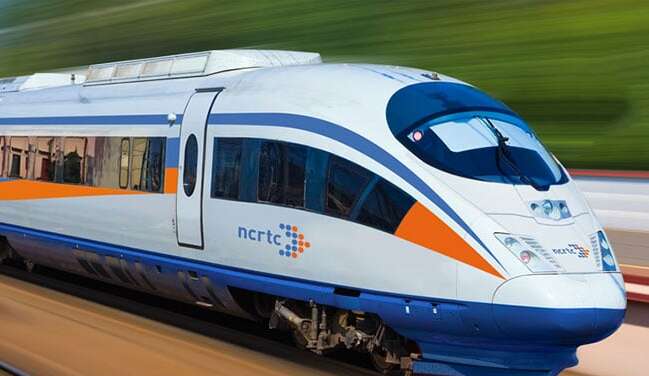
Delhi-Meerut RRTS: Bombardier wins rolling stock tender for India's 1st rapid rail project
The National Capital Regional Transport Corporation (NCRTC), which is the nodal agency executing the RRTS project, has recently finalized procurement of the RRTS project's rolling stock, in which Bombardier emerged the winner.

Bombardier Transportation India Private Limited has won the rolling stock tender for the Delhi-Ghaziabad-Meerut regional rapid transit system (RRTS), which is the country’s first regional rapid corridor coming up in the national capital region. The National Capital Regional Transport Corporation (NCRTC), which is the nodal agency executing the RRTS project, has recently finalized procurement of the RRTS project’s rolling stock, in which Bombardier emerged the winner.
Sudhir Sharma, Chief Public Relation Officer (CPRO), NCRTC told The Federal that the broad scope of work includes the design, manufacture, supply, testing, and commissioning of all train sets for Delhi-Meerut RRTS. He added that the tender capital cost of supply is Rs 1560 crores, excluding taxes.
According to NCRTC, the entire rolling stock for the 82 km long Delhi-Ghaziabad-Meerut corridor will be manufactured in India, marking a 100 per cent local manufacturing. The train sets will be manufactured by M/s Bombardier Transportation India Private Limited at their Savli plant in the state of Gujarat under the central government’s ‘Make in India’ initiative.
As against the ‘Make in India’ bid requirement of at least 75 per cent quantity to be compulsorily manufactured in the country and purchase preference given to manufacturers using more than 50 per cent local content, the winning bid offered to manufacture 100 per cent of the rolling stock in the country using 83 per cent local content. This means that there will be 100 per cent local manufacturing, and NCRTC will exceed the 75 per cent requirement.
Sudhir Sharma explained that as per the terms, the delivery of the rolling stock for the project will start in the year 2022. The broad scope of the tender work includes the design, supply, and commissioning of 40 RRTS train sets which are classified as follows:
1. 30 RRTS train sets of six cars each for operating regional transit services across the Delhi-Ghaziabad-Meerut route
2. 10 RRTS train sets of three cars each for operating local Meerut transit services only in Meerut.
Delhi-Ghaziabad-Meerut RRTS train features:
- The RRTS rolling stock will be first of its kind in India with a design speed of 180 kmph and an attainable operational speed of 160 kmph.
- The high-speed aerodynamic train sets will be self-propelled on electric traction
- The RRTS train will be designed according to the high-acceleration and high-deceleration that the train needs to undergo given the high operational speed of 160 kmph and RRTS stations at intervels of every 5-10 km.
- The trains will have automatic plug-in type sliding doors to reduce the friction in regular operations.
- For passenger’s convenience, the RRTS trains will have two-by-two transverse seating arrangement like the Indian Railways’ Shatabdi Express trains, besides comfortable standing space.
- The trains will be equipped with modern facilities such as CCTV, luggage space.
- The air-conditioned RRTS trains will have economy coaches as well as business class.
- One coach per RRTS train will be reserved for business class and one coach will be reserved for women passengers.
Once operational, the semi-high speed Delhi-Ghaziabad-Meerut RRTS corridor will reduce the travel time between Delhi and Meerut to just 55 minutes. It will cover a distance of 82 km through its rapid rail coaches on a ballastless track. The corridor will cover a total of 22 stations, across both elevated and underground sections.
The priority section of the Delhi-Ghaziabad-Meerut RRTS will the 17 km long Sahibabad-Duhai segment, which has been targeted for operations by the year 2023.
RELATED NEWS: Delhi-Meerut RRTS: Pre-bid meeting attracts prospective bidders from Japan, China
The RRTS project will have multi-modal integration with other modes of public transport such as Delhi Metro, Indian Railways stations as well as inter-state bus terminals (ISBTs).
Apart from Delhi-Ghaziabad-Meerut RRTS corridor, the other two priority corriodors in phase-1 are Delhi-Gurugram-Rewari-Alwar RRTS corridor and Delhi-Sonipat-Panipat RRTS corridor. These three corridors will converge at the Sarai Kale Khan RRTS station in Delhi.
A key feature of the RRTS project is interoperability of all its priority corridors, which facilitates a seamless commuter movement as they can travel from one corridor to another, without changing the train.
The RRTS trains will be operated with the European train control system (ETCS) Level 2 signalling system, which is being used in India for the very first time. ETCS Level -2 signalling system will not only facilitate the interoperability but will also ensure the train movement at quick frequencies, eventually reducing the waiting time for passengers.

